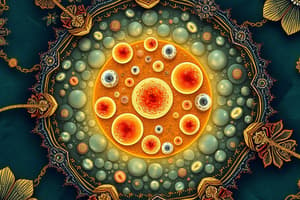Podcast
Questions and Answers
What is the primary function of the nucleus in a cell?
What is the primary function of the nucleus in a cell?
- Control of cell activities (correct)
- Protection against pathogens
- Protein synthesis
- Energy production
Which component is unique to plant cells and aids in photosynthesis?
Which component is unique to plant cells and aids in photosynthesis?
- Cell membrane
- Mitochondria
- Chloroplasts (correct)
- Ribosomes
What role do decomposers play in an ecosystem?
What role do decomposers play in an ecosystem?
- They are the primary consumers of energy
- They break down dead organisms and recycle nutrients (correct)
- They capture sunlight for energy
- They compete with producers for resources
What are the biotic factors in an ecosystem?
What are the biotic factors in an ecosystem?
How do consumers obtain energy in an ecosystem?
How do consumers obtain energy in an ecosystem?
Which of the following is essential for maintaining ecosystem health?
Which of the following is essential for maintaining ecosystem health?
What is the function of the cell membrane?
What is the function of the cell membrane?
Erwin's law states that energy flows through ecosystems primarily through what?
Erwin's law states that energy flows through ecosystems primarily through what?
Flashcards
Cell
Cell
The basic unit of life, forming all living organisms from simple to complex.
Ecosystem
Ecosystem
The complex interaction between living things (biotic) and non-living things (abiotic) in a specific area.
Abiotic factors
Abiotic factors
Non-living components of an ecosystem, such as sunlight, water, and soil.
Cellular respiration
Cellular respiration
Signup and view all the flashcards
Producer
Producer
Signup and view all the flashcards
Consumer
Consumer
Signup and view all the flashcards
Trophic Level
Trophic Level
Signup and view all the flashcards
Biodiversity
Biodiversity
Signup and view all the flashcards
Study Notes
Cell Biology
- Cells are the basic units of life. All living things are composed of cells, from single-celled organisms to complex multicellular ones.
- Cells have different shapes and sizes, adapted to their specific functions.
- Key components of animal cells include the nucleus (controls cell activities), cytoplasm (gel-like substance), cell membrane (controls what enters and leaves), mitochondria (powerhouse of the cell), and ribosomes (protein synthesis).
- Plant cells have similar components to animal cells, but also include cell walls (for support and protection), chloroplasts (for photosynthesis), and a large central vacuole (for storage).
- Cells utilize energy through cellular respiration, transforming nutrients into usable energy (ATP).
- Specialized cells in multicellular organisms work together in tissues to perform specific functions. Tissues combine to form organs, and organs to form organ systems.
Ecosystems
- An ecosystem encompasses all living organisms (biotic factors) and the non-living environment (abiotic factors) in a specific area.
- Abiotic factors include sunlight, water, soil, temperature, and minerals.
- Biotic factors include plants, animals, fungi, and bacteria.
- Energy flows through an ecosystem via food chains and food webs.
- Producers (plants) capture energy from sunlight through photosynthesis to create their own food.
- Consumers (herbivores, carnivores, omnivores) obtain energy by consuming other organisms.
- Decomposers (bacteria and fungi) break down dead organisms and return nutrients to the soil.
- Different trophic levels represent the different feeding positions in the food chain or web.
- Ecosystems are dynamic and constantly changing due to natural processes and human activity.
- Factors such as predation, competition, symbiosis (mutualism, commensalism, parasitism) impact the balance of an ecosystem.
- Nutrient cycles (carbon, nitrogen, water) are essential for maintaining ecosystem health.
- Biodiversity is crucial for ecosystem stability and resilience. A wide array of species increases the ecosystem's ability to withstand disturbances.
- Harmful interactions, such as pollution and habitat destruction, can disrupt ecosystem balance.
Studying That Suits You
Use AI to generate personalized quizzes and flashcards to suit your learning preferences.




